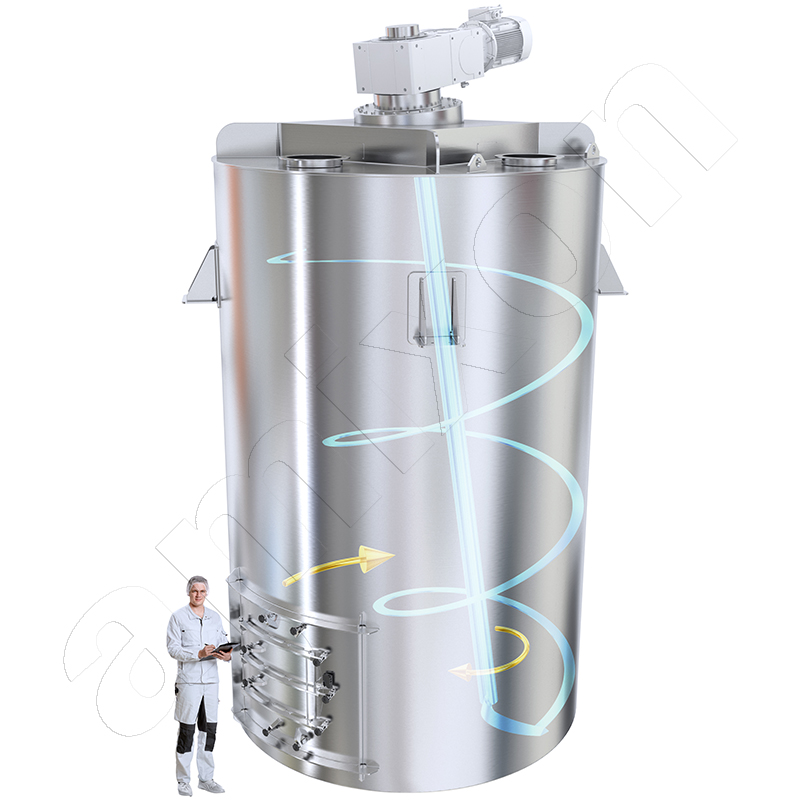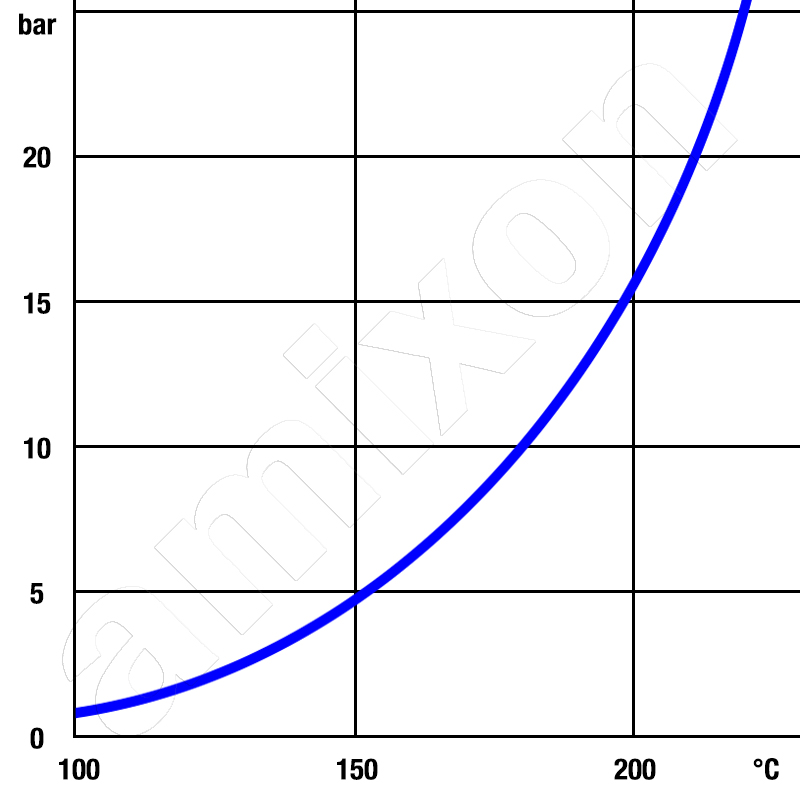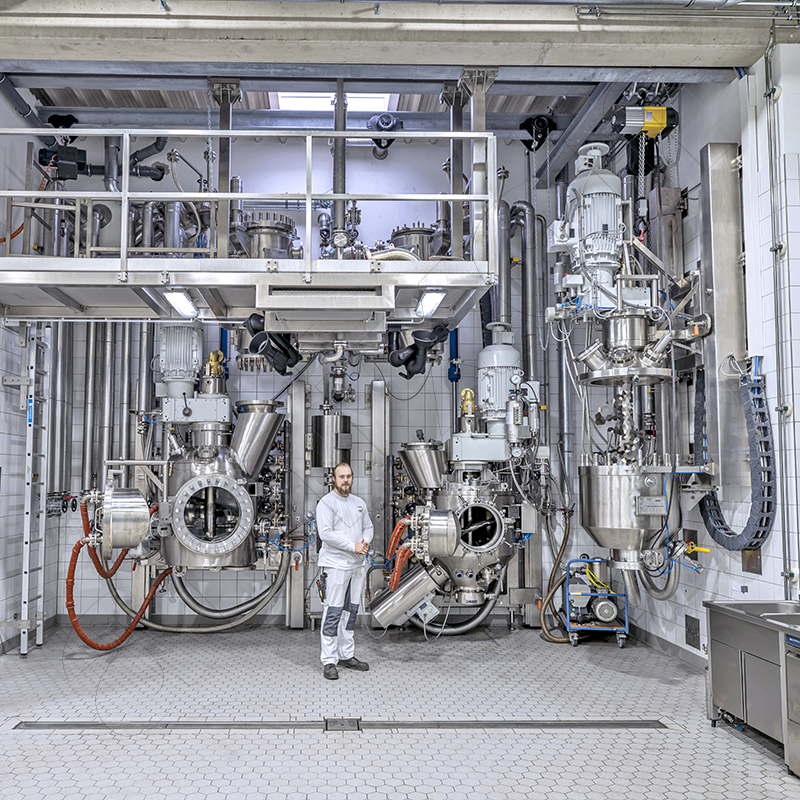Mixers, reactors for powdered thickeners, binders, stabilisers
Thickeners play an important role in the processing of food, pharmaceuticals, dietary supplements and chemical products. Due to many overlapping properties, thickeners sometimes fulfil additional functions. They can then be thickeners, stabilisers and binders at the same time. In rare cases, they are even made into active ingredients.
Homogeneity, dust-free, purity and a defined grain size are important quality characteristics of powdered thickeners. amixon® mixers are characterised by the fact that the above-mentioned quality characteristics are also maintained in very large batches.
The vast majority of thickeners are of vegetable origin
- Thickeners of vegetable origin: guar gum, pectin, starch, lecithin, carrageenan, alginate, xanthan gum, carrageenan, locust bean gum, agar-agar, gum arabic, gum tragacanth , konjac, glucomannan, cellulose derivatives: cellulose ether, carboxymethylcellulose (CMC), methylcellulose, hydroxypropyl methylcellulose, polyacrylic acid, sago, karaya gum,....
- Thickening agents of animal origin: gelatine, casein, egg white, chitin, chitosan, lanolin, bone meal, ...
- Thickening agents from biotechnological production: xanthan gum, gellan gum, curdlan, scleroglucan, dextran, ...
- Thickening agents from synthetic production: polyvinyl alcohol, polyacrylic acid, ...
Powdered thickeners must be homogeneous
Thickeners used in industry are traded as powders. They are usually dissolved in water during the end use. As powdered additives, they are used in tablets, instant soups and sauces, food supplements, protein shakes, cosmetics and instant beverages. In special cases, they are also used in liquid form. This is the case, for example, when the thickening agent is used as an agglomeration aid and binder.
Thickeners are also used as lubricants and gliding agents. Technical applications are found in mechanical engineering, in construction chemistry, in plastics technology, in conveyor technology and in deep drilling in rock. Some thickeners are also flocculants and are used in water treatment. Long-chain, water-soluble polymers can bind suspended matter.
Thickeners are functional additives. They usually do not react with active ingredients and fillers. Despite their low proportion in the recipe (about 0.3 to 6% by weight), they have a major influence on the end product. In particular, on the appearance and stability. For this reason, it is important that the thickeners used are homogeneous. Only in this way can it be ensured that a given amount always has the same optimal effect on the end product.
amixon® mixers are ideal for homogeneously mixing powdered thickening agents. The mixing process is particularly gentle. amixon® mixers can bind or agglomerate dust-forming components during mixing.
amixon® mixers improve:
- the absence of dust and the flowability of the powders
- the sinking behaviour, the dispersion and the solubility in liquids
Thickeners are crucial to the quality of many end products
Powdered thickeners, binders and stabilisers are mass-produced. However, it must be ensured that their use does not result in microbiological contamination of the end product. The properties of thickeners must be precisely defined in order for them to be used industrially. Some important properties of thickeners are listed below by way of example:
- germ-free or even sterile
- stability of the viscosity setting
- rheological effect: creamy, stiff, gel-like, coagulating, flocculating
- resulting coagulate: floating, sinking, suspended, adhering, etc.
- rapid solubility without clumping
- resistance to temperature changes
- pH stability
- Adjustable shear behaviour (Newtonian, pseudoplastic, dilatant, rheopex, etc.)
- Compatibility with existing active ingredients, fillers, colourants and excipients. Thickeners must not adversely affect the flavour, colour and mouthfeel of the food.
- Dosability, dust-free
- distribution and miscibility in powdery or liquid end products
- Thickening agents dissolved in water: improve the visual appearance. Some thickening agents (e.g. starch) have a natural cloudiness, while others (e.g. carrageenan) produce a clear solution
- Shelf life
Sterilisation and enzyme deactivation in the amixon® reactor
Some thickening agents can be sterilised with steam. The amixon® sterile reactor is preheated to approx. 120°C or 130°C. Then the device is filled with the powdered thickening agent. Vacuum is applied. Then a small amount of steam is introduced. The saturated steam condenses on the surfaces of the particles. The heat transfer from the steam to the individual particles is spontaneous and very even. The microorganisms are killed by the intense heating.
The simultaneous mixing process homogenises the powders, preventing agglomeration. The pressure in the sterile reactor increases in line with the temperature increase and the steam injection. The treatment time is usually 5 to 15 minutes.
After that, a vacuum is applied. The water introduced evaporates very quickly. In this way, the powder can be cooled very effectively.
The water vapour must only condense on the powder particles
It is very important that the process chamber is fully heated. Any part of the process chamber that is colder than the dew point is a source of condensation. At these points, the water vapour introduced would condense into water. It would contaminate the mixing chamber. It would moisten the powder uncontrollably and cause clumping.
The condensation of water vapour is essentially determined by the temperature and pressure of the system. Higher pressure and higher temperature lead to a higher dew point.
It is particularly important that the mixing tool is also fully heated. Otherwise, it would be heated by the mixture. Condensate would then form. At these points, the mixing tool would become contaminated in an uncontrolled manner.
For this reason, amixon® machines have a sophisticated heating system. This also applies to the mixing tool shaft, mixing arms and mixing spirals. No matter what medium you use for heating/cooling.
- Steam,
- water (possibly under pressure)
- thermal oil
amixon® meets other important requirements:
- The mixing tool is only mounted above the mixing chamber
- There is no contact between the mixing tool and the mixer floor.
- The distance between the floor and the mixing tool is only a few millimetres.
- Mixing is carried out without dead space.
- The mixing tool is completely oversized according to the strength calculation.
- Even when mixing heavy goods, only minimal elastic deformations occur at the mixing tool.
- There is no contact between the mixing tool and the vessel wall.
Gaining knowledge through trials at the amixon® technical centre
amixon® offers a platform for the exchange of information. This happens across industries. Sometimes processing tasks are similar in ways you might not expect. In these cases, it is particularly useful to be able to directly test a solution concept that is highly likely to work well.
amixon® can extrapolate process parameters for almost all industrial dimensions. This applies to both mixing and thermodynamic processes. However, the exchange of information always takes place while safeguarding customer interests and maintaining strict confidentiality.
© Copyright by amixon GmbH













